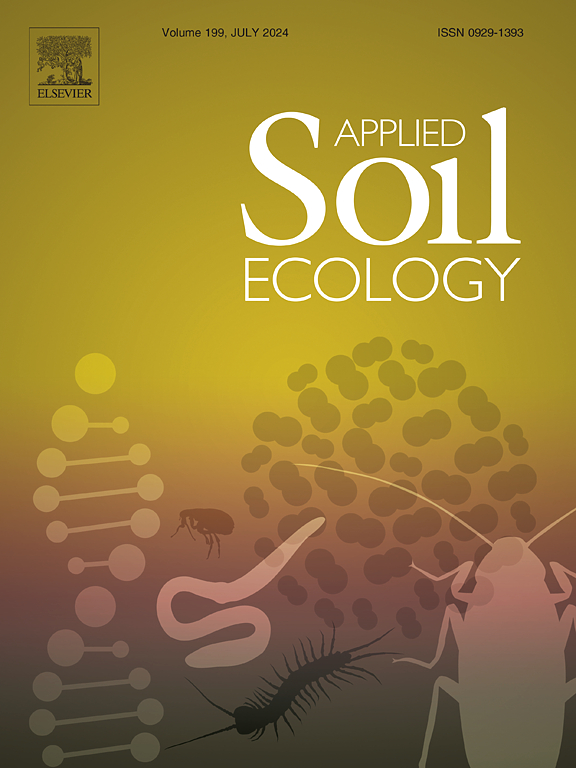Nitrogen-salt interaction in Pennisetum giganteum: Effects on soil, rhizosphere, and ion transport processes
IF 4.8
2区 农林科学
Q1 SOIL SCIENCE
引用次数: 0
Abstract
The continuous expansion of soil salinization poses challenges to agricultural development. Nitrogen (N), the most commonly used fertilizer, helps alleviate salt stress either at appropriate concentrations or through N assimilation. Fertilization management is crucial for plant survival and saline soil quality. Although the individual effects of N and salt have been widely studied, their combined impact on Pennisetum giganteum (P. giganteum) remains insufficiently explored. In this study, laboratory and field experiments were combined to investigate changes in soil N transformation, salt ion transport in P. giganteum, and the effects of N-salt interaction on the rhizosphere microbial community (RMC). The results indicated that N-salt interaction increased P. giganteum height and yield by 50.80 % and 67.23 %, respectively. The structural equation model indicated that N uptake had the most significant effect on yield (path coefficient = 0.963), with NO3−-N positively affecting N uptake. NO3−-N was more strongly correlated with height and yield than NH4+-N. 16S sequencing, principal coordinate analysis, and redundancy analysis revealed that denitrifying genera (e.g., Dechloromonas) decreased significantly under high-level N-salt interaction, while nitrification-related genera (e.g., Nitrospira) increased, thereby generating more NO3−-N to promote P. giganteum growth. Soil electrical conductivity was the key factor affecting the RMC at the tillering stage. Additionally, P. giganteum may adapt to different salinity levels through distinct salt tolerance mechanisms. This study confirmed that N alleviates salt stress, and revealed the mechanisms of N transformation in the rhizosphere microenvironment and the transport of salt ions in P. giganteum under N-salt interaction.

狼尾草氮盐相互作用:对土壤、根际和离子传输过程的影响
土壤盐碱化的持续扩大给农业发展带来了挑战。氮(N)是最常用的肥料,在适当的浓度下或通过氮素同化有助于缓解盐胁迫。施肥管理对植物生存和盐碱地质量至关重要。尽管氮和盐的个体效应已被广泛研究,但它们对巨型狼尾草(P. giganteum)的综合影响仍未得到充分探讨。本研究采用室内和田间试验相结合的方法,研究了土壤氮素转化、盐离子输运的变化以及N-盐互作对根际微生物群落的影响。结果表明,n -盐互作可使巨藻株高和产量分别提高50.80%和67.23%。结构方程模型表明,氮素吸收对产量的影响最为显著(通径系数= 0.963),NO3−-N正影响氮素吸收。NO3−-N比NH4+-N与株高和产量的相关性更强。16S测序、主坐标分析和冗余分析显示,在高水平n-盐作用下,反硝化属(如脱氯单胞菌)显著减少,而硝化相关属(如硝化螺旋菌)增加,从而产生更多的NO3−-N,促进P. giganteum的生长。分蘖期土壤电导率是影响土壤RMC的关键因素。此外,巨藻可能通过不同的耐盐机制来适应不同的盐度水平。本研究证实了N对盐胁迫的缓解作用,揭示了N-盐相互作用下巨桫椤根际微环境中N的转化和盐离子的转运机制。
本文章由计算机程序翻译,如有差异,请以英文原文为准。
求助全文
约1分钟内获得全文
求助全文
来源期刊

Applied Soil Ecology
农林科学-土壤科学
CiteScore
9.70
自引率
4.20%
发文量
363
审稿时长
5.3 months
期刊介绍:
Applied Soil Ecology addresses the role of soil organisms and their interactions in relation to: sustainability and productivity, nutrient cycling and other soil processes, the maintenance of soil functions, the impact of human activities on soil ecosystems and bio(techno)logical control of soil-inhabiting pests, diseases and weeds.
 求助内容:
求助内容: 应助结果提醒方式:
应助结果提醒方式:


